The American economy has been
doing very well lately. The expansion that began in the early
1990s is now more than nine years old, the longest expansion in
American history. Usually as expansions age, productivity growth
drops, and inflation picks up. But in this expansion, just the
reverse is happening. In 1999, productivity rose at a very high
rate, unit labor costs barely increased, and core measures of
price inflation were relatively stable. Stock market values rose
so high that the earnings-price ratios on broad common stock
indexes have dropped to almost the real rate of interest on
Treasury bonds. Real wages rose across the board, for high- and
low-wage workers alike. Unemployment rates fell to near historic
lows, and to historic lows for minority groups. Budget surpluses
rose to historic highs.
Scholars will debate why and how
all these good things happened. In particular: Why after
twenty-five years of low productivity growth, did productivity
suddenly pick up? Why after twenty-five years during which the
noninflationary unemployment rate seemed to be around 6 percent,
did this rate suddenly seem to drop to 5 percent or perhaps even
lower? The answers to these mysteries are likely to be found in
some combination of deregulation, the information technology
revolution, competitive pressures flowing from increased
globalization, and in recent years, the Internet. But some
traditional factors should also be recognized--plain old
investment and saving have been very high.
In 1999, national saving was
about 19 percent of gross domestic product (GDP), around the
average level over the last four decades but higher than the
saving ratio has been for fifteen years. Capital investment was 21
percent of GDP in nominal terms, nearly a historic high and again
higher than the nominal investment ratio has been for fifteen
years. Because of the declining relative price of capital
investment, in real terms investment has risen even more. And
because of a further rise in the share of investment comprising
high-technology equipment and software, the productivity-enhancing
impact of this investment was higher yet. The President’s
Economic Report attributes one-third of the recent significant
pickup in productivity growth to capital deepening, essentially
reflecting the investment boom, with another, smaller amount due
to improvements in the production of computers. Board staff
economists Stephen Oliner and Daniel Sichel go even further,
attributing two-thirds of the productivity pickup to the use of
information technology together with improvements in the
production of computers and semiconductors.
In this talk I discuss four
factors that have contributed to the rising importance of real
capital investment. Two factors on the saving side, foreign
capital inflows and government budget surpluses, have made
possible the increase in investment’s share of GDP in nominal
terms. Two factors from the investment side, the declining
relative price of capital investment and the growing share of
high-technology investment, explain why the
productivity-increasing effect of this investment is particularly
large.
But the mere presence of an
investment boom is not the end of the story, because investment is
a notably cyclical component of overall spending. In the second
part of the talk I mention some factors that may help sustain this
investment boom. This leads to a discussion of the challenging
role of monetary policy in smoothing cycles for both investment
and aggregate demand.
Saving
A logical starting point is to discuss the saving that finances
investment. In a closed economy, investment spending can be shown
to be equal to national saving. In an open economy, investment
equals the sum of national saving and the nation’s net surplus
of imports over exports. This import surplus represents the gap
between the value of the nation’s overall spending and its
production, or the amount of its investment not financed by
domestic saving. Alternatively, the import surplus can be thought
of as the buildup of foreign claims on a nation’s assets, or the
degree to which foreigners purchase new domestic capital.
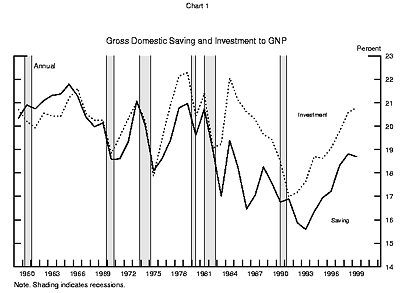
Magnitudes over the last four
decades are shown in chart 1. The graph is in nominal terms,
deflated by nominal gross national product (GNP). The latter is a
better deflator to use for national saving than GDP because GNP
measures the total income earned by domestic citizens. The story
of the graph is easily told. While national saving as a share of
GNP, the solid line, has recovered from its lows in the early
1990s and is now roughly at its four-decade average, total capital
investment has risen to nearly 21 percent of GNP, close to the
peak for the period depicted. The difference is the foreign saving
that is financing U.S. capital spending, or the U.S. import
surplus. Because that import surplus is high, our nation has been
able to finance much more investment than would have been the case
were we relying solely on our own saving.
Will this foreign source of
funds for U.S. capital investment continue? Perhaps not. Models of
capital investment are usually formulated in portfolio balance
terms, and for the contribution of foreign saving to continue,
foreigners would have to continue to build up their stocks of U.S.
assets--most of which are denominated in dollars. These stocks are
already at historic highs, and most economists figure that, at the
very least, stocks will not continue rising indefinitely relative
to GNP or relative to foreign wealth or income. Should the stock
of foreign holdings of claims on U.S. assets level off, the
implied foreign saving contribution to U.S. investment will
decline toward zero, and the U.S. capital investment and saving
ratios in chart 1 will converge. If part of the converging is done
by investment, at least this component of the investment boom will
be limited.
The contribution of foreign
saving to the U.S. investment boom rose as the U.S. economy grew
more rapidly than foreign economies, hence simultaneously
spreading aggregate demand to foreign countries and providing a
higher return outlet for foreign saving. In either sense, the U.S.
import surplus has helped to stabilize the world economy over the
past few years. But now that foreign economies are recovering,
U.S. exports may rise, cutting into the import surplus, and rates
of return in foreign countries may rise, cutting into the flow of
foreign saving to this country.
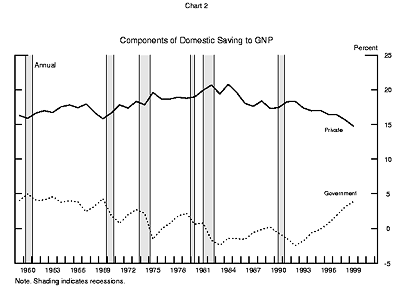
A second source of financing is
from the domestic economy. In chart 1, national saving recovered
from its low in 1993 to a value of roughly 19 percent of GDP by
1999, close to its four-decade average. Chart 2 offers a more
detailed look at national saving, splitting it into its private
and public components. Private saving, the sum of saving by
households and businesses, has tailed off lately, dropping to
about 15 percent of GDP. The main reason for the decline is the
large drop in household saving, presumably because households feel
less need to save out of current income when stock market and
housing values are rising.
But government saving has
prevented overall national saving from declining. Government
saving has risen from less than zero to nearly 5 percent of GNP
over the last seven years, more than offsetting the drop in
private saving. The higher government saving reflects the first
period of sustained federal surpluses since World War II.
Will these federal government
surpluses continue? The simple answer would seem to be no, that
politicians will find a way to spend the money. But some new
developments may suggest a different outcome.
The federal surplus is made up
of two components. One is the cash-flow surplus of the social
security trust fund; the other is the surplus for all other
programs, which I will call the general government surplus. The
social security trust fund projects a long-term actuarial deficit.
But because social security payroll taxes have been increased in
advance of the retirement of the baby boomers, the system’s
trust fund is likely to run a cash surplus of about $150 billion
in fiscal 2000. Forecasts indicate that this surplus is likely to
rise about $15 billion per year for the next few years.
Although politicians on both
sides of the political aisle know that changes in social security
must be made to ensure the long-term actuarial solvency of the
system, they have been at a stalemate on making actual changes.
Almost any cuts in benefits, whether now or far in the future, are
intensely criticized, as are increases in payroll taxes. The
consequence is that no benefit or tax changes have been made, none
are immediately likely, and social security’s cash surplus is
likely to continue. The further consequence is that politicians do
not want to be seen threatening social security in any way, and in
today’s not entirely informed political atmosphere, even
borrowing from social security by running a general government
deficit has become viewed as threatening social security. Hence it
is likely that at least until this political gridlock is resolved,
the overall federal surplus should be at least as high as the
presently forecast cash surplus of social security. Simply
retaining this surplus will continue the level of government
saving shown in chart 2.
While the political dynamics of
what I might call social security nonreform suggest that the
overall federal surplus will be at least as high as the cash
surplus of social security, several points should be kept in mind.
First, in contrast to what one often hears in political debate,
this stalemate does nothing to facilitate the programmatic changes
that are necessary to deal with the nation’s long-term social
security problem. Some changes in program taxes or benefits or
both still must be made.
Second, if there is to be an
actual constraint against running general government deficits,
realistic projections do not show all that much revenue available
for non-social security tax cuts or spending increases for some
years. The Congressional Budget Office has made several budget
projections this year, differing according to the future treatment
of the spending caps, which lately have been widely ignored. The
most realistic of these long-term projections, assuming present
levels of real discretionary spending over the next decade, puts
the projected general government surplus at $838 billion over the
next ten years, which seems like a lot. But this budget projection
assumes that spending appropriations will not rise at all in real
terms, that commonly extended tax reductions will not be extended,
and that the economy will avoid recessions for the entire ten-year
period. Even under these generous assumptions, the general
government surpluses are barely positive for the next six fiscal
years, hitting the big numbers only later in the decade.
As a final issue, if it is in
fact true that the social security surpluses will accumulate
because of the politics of nonreform, it will not be too long
before the $3.5 trillion of outstanding federal debt will be paid
off. Not permanently, because the same forecasts that show the
debt being paid off also show it building back up later in the
twenty-first century, when the U.S. population begins to age
significantly. But it is possible that for a period of years the
economy will be operating with little or no Treasury debt. Is this
a problem?
Basically no. Although private
markets have used Treasury securities as their safe and highly
liquid benchmark bonds, markets are innovative and will find a
substitute. Already the so-called swaps market is filling this
roll. Private investors are increasingly turning to this market as
their preferred method of hedging risks.
A related problem involves the
ability of the Fed to provide for growth in currency and bank
reserves, hence providing for growth in overall liquidity.
Traditionally, the Fed has accomplished this reserve growth by
adding to its holdings of Treasury securities, securities that may
soon no longer be available. But the Fed has alternative ways to
generate growth in reserves. The Federal Reserve Act authorizes
the Fed to generate reserves through purchases of a range of other
assets or through temporary repurchase agreements backed by such
assets. The Fed could also expand the role of the discount window
in supplying reserves.
For those who have long
championed higher national saving, such as me, the rise in
government saving is welcome, as is the tentative political truce
in favor of at least retaining the likely future social security
surpluses. The United States is still a long way from being a
high-saving country, and as chart 1 showed, national saving is now
at average historical levels, not at high levels. But even this
situation looks far more promising than it did a decade ago, even
than it did a few years ago.
Investment
High investment ratios in nominal terms tell only part of the
story. The long-term drop in relative prices of capital goods, due
partly to computers but to other types of equipment as well, means
that a dollar of nominal saving buys much more real capital than
in the past.
It is somewhat complicated to
adjust for drops in relative prices. GDP price indexes are now
chain-weighted, which means that the weights used to aggregate the
components of real GDP are automatically updated to reflect recent
changes in the relative prices of different components of GDP.
Technically, this procedure generates a growth rate of real GDP
rather than a level. To obtain levels, the Bureau of Economic
Analysis selects a base year and sets real spending levels equal
to nominal spending levels in that year. In all other years, real
spending levels for individual components will not sum to real
GDP. This makes it misleading to focus on the absolute level of
investment ratios.
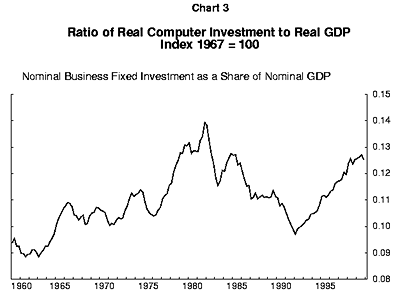
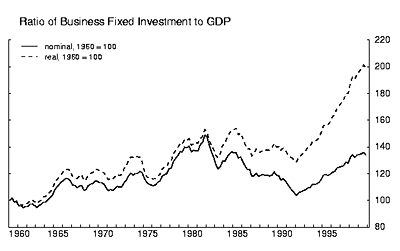
Although the level of the real
share of investment spending is not meaningful, one can still
examine trends by creating an index of the real investment ratio.
This index does not solve the adding-up problem, but it does
prevent misinterpretation of the level of the ratio. Such an index
is shown in chart 3. The top panel of the chart gives the ratio of
business fixed investment in nominal terms to GDP in nominal
terms. Business fixed investment is a more restrictive category of
investment than the total investment shown in chart 1 because it
omits residential investment and inventory investment. But the
time pattern is reasonably similar to that shown for the nominal
investment ratio in chart 1, with a slightly increased upward
trend.
Then the bottom panel shows this
nominal ratio, indexed to 100 in 1960, and the ratio of real
investment to real GDP, also indexed to 100 in 1960. The nominal
and real ratios are similar until the early 1990s, though the real
ratio does show a stronger trend because relative prices of
capital goods have dropped over the period as a whole. But
beginning in 1992, the real ratio takes off and reaches a record
high in 1999.
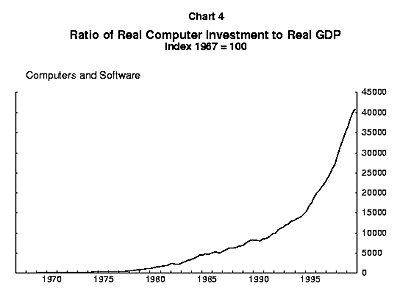
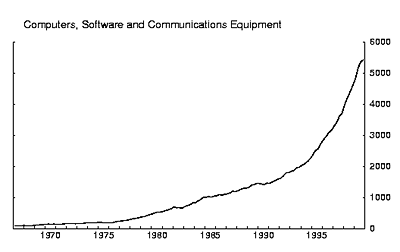
The last factor is the
increasing importance of high-technology investment. This trend is
shown in chart 4. The top panel of the chart shows an index of the
ratio of real computer and software investment to real GDP. The
bottom panel broadens this look by also including real
communications investment in the numerator. Either way, the ratio
of real high-technology investment to real GDP is soaring. It
increased 400 times in the top panel and more than 50 times in the
bottom panel. The changes have been especially sharp in the last
few years. Because of high rates of depreciation and obsolescence
for this high-tech equipment and software, these investments have
very high gross rates of return and are particularly significant
in contributing to overall productivity change.
Oliner and Sichel have attempted
to determine the effect of these changes on overall productivity,
using a neoclassical production function analysis. They break
capital into various information technology components (hardware,
software, and communications) and estimate the contribution of
each piece. They find that of the roughly 1percentage point
increase in productivity growth rates in the second half of the
1990s, the use of information technology capital has added about
0.5 percentage points a year to the growth of labor productivity.
But this does not tell the entire story because multifactor
productivity, the production function residual, could be further
influenced by productivity advances in the production of
semiconductors and computers. They estimate that this second
factor accounted for about 0.2 percentage points a year. Thus they
find that information technology equipment has been responsible
for about two-thirds of the recent pickup in overall productivity
growth. Even this estimate does not count the effect of other
types of capital investment, which have been present but have not
increased in the late 1990s. And while productivity advances due
to the Internet are included in their estimate, these effects
could become much larger very soon.
However productivity is
explained, whether by overall real capital investment or more
narrowly by real capital investment in information and
communications technology, there has been a sharp pickup recently.
Moreover, there is little doubt that at least some forms of
capital investment have played a key role.
Sustainability
Investment is a notoriously cyclical component of spending. It is
great that the economy is enjoying an investment boom now. A key
question is whether this boom will last.
Nothing in the nature of
productivity shocks outlaws business cycles. Indeed, the higher
investment goes now, the more we might expect it to recede later.
Accelerator models of investment behavior work by having capital
investors buy new equipment to produce higher levels of output.
But once output stops growing, the desired capital stock stops
growing as well, implying sharp declines in the level of
investment. Is the U.S. economy merely enjoying a traditional
accelerator-induced investment boom?
At least two natural factors
might tend to downplay accelerator fears. One natural factor is
the extremely low level of inventory stocks, the usual activating
device for typical accelerator-type business cycles in the past.
One of the subtle effects of technology has been that it allows
firms to manage inventories more closely, hence reducing the
importance of inventory cycles.
The second natural factor is the
nature of this new capital investment. Board economists Stacey
Tevlin and Karl Whelan show that much recent investment is
propelled by the dropping level of relative prices and the high
rate of depreciation. Essentially, declining relative prices have
induced firms to buy high-technology capital, which depreciates
rapidly, inducing firms to buy even more high-technology capital.
While Tevlin and Whelan do find accelerator influences in this
process, the investment accelerator is less of a factor than with
traditional forms of investment. If their story is accurate, it is
one of continued increases in a significant component of capital
investment, with much less emphasis on the accelerator cycle.
But even in view of these
considerations, cycles in aggregate demand and capital investment
have often occurred in the past and are certainly possible in the
future. The investment accelerator may have been weakened, but it
has by no means been abolished. This leads to policy
considerations and specifically to challenges facing monetary
policy.
Modern textbook theories of what
used to be called the assignment problem suggest that when an
economy is open to international trade and capital flows, with
flexible exchange rates, as is the U.S. economy, fiscal policy
should be used to set the long-term or normal saving rate, and
monetary policy should be used to stabilize the economy. Fiscal
policy cannot have significant effects on overall output because
fiscal shifts are systematically offset by exchange rate
movements, leading to minimal changes in output but significant
changes in national saving. For example, contractionary fiscal
policy directly lowers consumption, lowering interest rates and
currency values and raising net exports to fill the output gap. In
the end, output is likely not to change much, but the composition
of this output will shift in favor of net exports and higher
national saving. This means that fiscal policy is not well-suited
for conducting stabilization policy. Exactly the same open-economy
forces mean that monetary policy is well-suited to conduct
stabilization policy. Expansionary monetary policy works by
stimulating domestic spending, driving down currency values, and
further stimulating net exports.
Whether intentionally or not, in
recent years the United States has followed this textbook
prescription almost perfectly. Fiscal policy has been
contractionary, as evidenced by the high and growing budget
surpluses, and has contributed to the moderately high levels of
national saving, as shown earlier in chart 2. Monetary policy has
let fiscal policy do its work in raising levels of national saving
and investment and then has been aimed at keeping overall output
near the level implied by the noninflationary rate of
unemployment, the rate below which inflation begins to increase.
The result has been an economy near full employment, with low and
stable inflation, with high national saving and investment ratios,
and with rapid productivity improvement.
In this sense there are two keys
to the sustainability of the investment boom. The first is whether
recent investment increases are likely to have greater staying
power, as suggested by Tevlin and Whelan’s results, or are
merely the product of an accelerator cycle. The second lies with
the central bank. The goal of monetary policy, as always, is to
try to ensure high employment and stable prices. The high
employment goal should, at least in principle, guard against
cyclical drops in investment demand; the stable price goal should
guard against overheating and costly increases in inflation. The
question is whether monetary policy can achieve these goals
simultaneously.
Two policy approaches have been
proposed recently for dealing with this delicate balancing act.
One favorite among academics is John Taylor’s rule. This rule
would have the Fed setting short-term interest rates equal to an
equilibrium nominal short rate, plus a term of forcing up nominal
rates if inflation rises and a term of forcing down nominal rates
if unemployment rises. Another favorite among academics, and this
time also many foreign central banks, is inflation targeting.
Inflation-targeting central banks use their inflation target to
anchor monetary policy. If inflation threatens, an
inflation-targeting central bank would tighten policy until
inflation is brought under control. It might appear that these
inflation-targeting central banks would ignore unemployment, but
in fact what most economists and central bankers mean by inflation
targeting is a more flexible approach. Specifically, if recession
threatens, most flexible inflation targeters would take action
against recession to prevent inflation from dropping below its
preset target.
Under normal circumstances there
might be little difference between following a Taylor rule
approach to monetary policy or an inflation-targeting approach.
Either way, the central bank will act against both impending
inflation and impending recessions. In either case, if
successfully done, monetary policy would be following its assigned
role of stabilizing the economy, which in this context means
preventing business cycles, and associated investment cycles. In
either case, the big challenge facing the central bank is policy
lags. If it takes time before monetary policy affects the economy,
either a Taylor rule central bank or an inflation-targeting
central bank will have to act sufficiently early, perhaps
preemptively, to neutralize the cyclical shocks. Doing that in a
time of forecasting uncertainty will not be easy.
Conclusion
There are many potential explanations for the recent good
performance of the American economy, but saving and investment
should certainly be included in the list. Increases in federal
government surpluses have returned overall national saving ratios
to average historical levels. Increases in the foreign financing
of U.S. investment have made possible further increases in nominal
investment ratios. Reductions in relative prices for capital
equipment spending have led investment still higher in real terms.
And compositional changes in favor of high-technology investment
have boosted even further the productivity impact of this
investment.
Moreover, the strong driving
force of lower capital goods prices, combined with rapid
depreciation of the high-technology capital, leads to at least the
possibility that this investment boom will prove more sustainable
than in the past. If not, monetary policy will have to play its
textbook role of stabilizing output at high but non-inflationary
levels.
